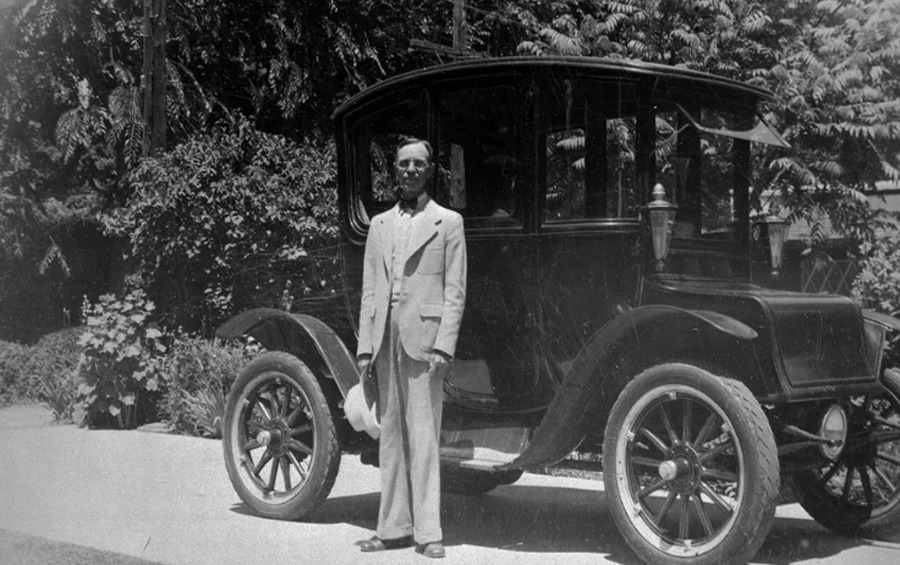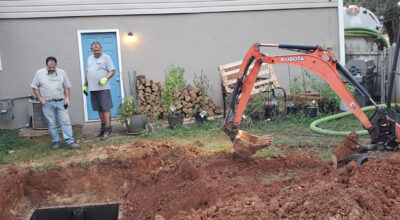
Oliver O. Fritchle stands in front of one of his cars. (Photo https://archive.curbed.com/2017/9/22/16346892/electric-car-history-fritchle)
We may have another good argument for traveling that can be made based on the statutory language itself.
By Christopher Sapp / midstate bureau chief / NoogaRadio Network
Get this — a “motor” is not the same thing as an “engine.” See https://www.kia.com/dm/discover-kia/ask/is-an-engine-a-motor.html.
Since electric “motors” weigh more than combustion “engines” a valid argument could be made that our state legislature, intending to make a distinction in the law through their choice of words so as to protect the health, safety, and welfare of the public; did so in order to protect folks from the increased hazards of the heavier weighted vehicles being operated upon the public right of way in case of accidents.
The Courts would shit their pants if this argument was presented correctly…after all, words have VERY specific meaning in contemplation of statutory construction.
Surely, had combustion powered engines been contemplated for regulation by our legislators they would have chosen those specific words rather than the “motor propelled” vehicles they have described.
Basically, an “engine” makes it’s own power (internal combustion), while a “motor” has it’s power supplied (batteries or electricity).
For example: Trains, planes, and most automobiles all have engines (steam, diesel, etc)…fans and trolley cars have motors.
From a historical perspective this has a weight of credibility as well when you consider that from the mid-1800’s until the early 1930’s electric carriages were a common means of transportation.
I think if we look back at the history of automobiles and the development of the transportation industry there is a precedent for regulation of “motor” vehicles as opposed to “combustion engine” vehicles.
Today the terms “motor” and “engine” are often conflated and used interchangeably but this hasn’t always been the case.
In the late 1800’s and early 1900’s electric powered automobiles made their debut. These “horseless carriages” were expensive and out of the price range of most individuals. In larger cities like New York, Chicago, Detroit, and Atlanta these horseless carriages became the preferred type of taxi which competed with horse drawn taxi services in shuttling people around town. The Packard Electrobat was one such “motor vehicle.”
Since being a “driver” of “passengers” in those days was both a vocation and regulable activity or “privilege” requiring licensure by the State, it is important for us to look at what types of vehicles were being regulated at the time…motor vehicles…which were generally all powered by electric motors at the time.
In due time trackless trolley coaches such as the Westinghouse Electrocam became more widespread and prolific for use in transporting passengers. These “motor vehicles” drew power from a system of overhead wires and were used for public transportation where the private “motor vehicles” had previously been powered by lead acid batteries. Operators of these motor carrier services all required licensing, registration, and insurance whereas wealthy persons who could afford to purchase private automobiles were not subject to such regulation unless engaged in commerce.
Since trackless trolly “motor vehicles” utilized public utility power lines to propel passengers along a route, this may be why our motor carrier laws appear under the same section of the TN code as public utilities and railways do…the electric lines being the “rails” upon which the transportation occurred.
This may also be why the term “vehicle” is distinguished from “motor vehicle” in TCA 55-1-103. Interestingly, most gas-powered automobiles meet the definition of a “vehicle” but do NOT meet the criteria of “low powered vehicles” or “medium powered vehicles” that constitute and define “Motor vehicles.”
Motor vehicles would necessarily include battery powered vehicles, low speed (gas/battery) vehicles, and medium speed (gas/battery) vehicles but NOT gas powered vehicles with a top speed exceeding 35mph.
http://www.trolleybuses.net/mem/mem.htm
http://www.trolleybuses.net/knx/knx.htm

